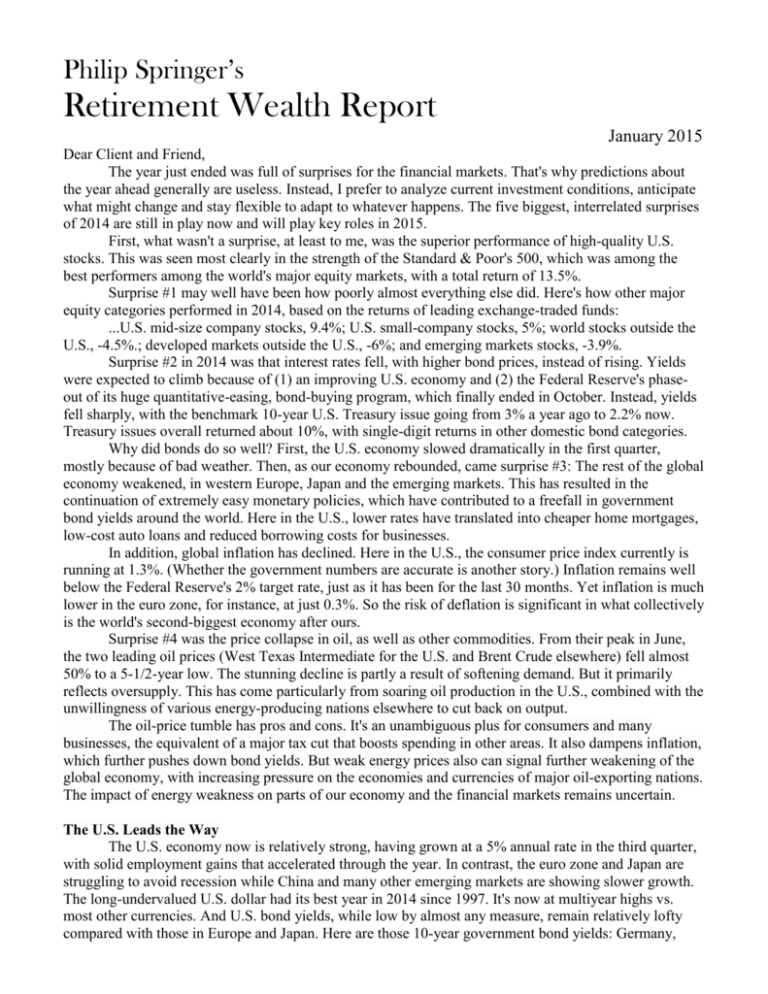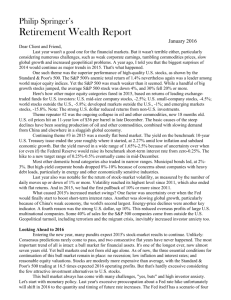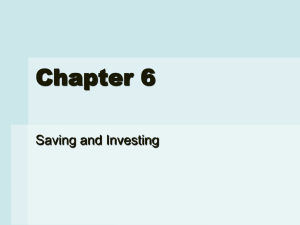Philip Springer`s - Retirement Wealth Management, Inc.
advertisement

Philip Springer’s Retirement Wealth Report January 2015 Dear Client and Friend, The year just ended was full of surprises for the financial markets. That's why predictions about the year ahead generally are useless. Instead, I prefer to analyze current investment conditions, anticipate what might change and stay flexible to adapt to whatever happens. The five biggest, interrelated surprises of 2014 are still in play now and will play key roles in 2015. First, what wasn't a surprise, at least to me, was the superior performance of high-quality U.S. stocks. This was seen most clearly in the strength of the Standard & Poor's 500, which was among the best performers among the world's major equity markets, with a total return of 13.5%. Surprise #1 may well have been how poorly almost everything else did. Here's how other major equity categories performed in 2014, based on the returns of leading exchange-traded funds: ...U.S. mid-size company stocks, 9.4%; U.S. small-company stocks, 5%; world stocks outside the U.S., -4.5%.; developed markets outside the U.S., -6%; and emerging markets stocks, -3.9%. Surprise #2 in 2014 was that interest rates fell, with higher bond prices, instead of rising. Yields were expected to climb because of (1) an improving U.S. economy and (2) the Federal Reserve's phaseout of its huge quantitative-easing, bond-buying program, which finally ended in October. Instead, yields fell sharply, with the benchmark 10-year U.S. Treasury issue going from 3% a year ago to 2.2% now. Treasury issues overall returned about 10%, with single-digit returns in other domestic bond categories. Why did bonds do so well? First, the U.S. economy slowed dramatically in the first quarter, mostly because of bad weather. Then, as our economy rebounded, came surprise #3: The rest of the global economy weakened, in western Europe, Japan and the emerging markets. This has resulted in the continuation of extremely easy monetary policies, which have contributed to a freefall in government bond yields around the world. Here in the U.S., lower rates have translated into cheaper home mortgages, low-cost auto loans and reduced borrowing costs for businesses. In addition, global inflation has declined. Here in the U.S., the consumer price index currently is running at 1.3%. (Whether the government numbers are accurate is another story.) Inflation remains well below the Federal Reserve's 2% target rate, just as it has been for the last 30 months. Yet inflation is much lower in the euro zone, for instance, at just 0.3%. So the risk of deflation is significant in what collectively is the world's second-biggest economy after ours. Surprise #4 was the price collapse in oil, as well as other commodities. From their peak in June, the two leading oil prices (West Texas Intermediate for the U.S. and Brent Crude elsewhere) fell almost 50% to a 5-1/2-year low. The stunning decline is partly a result of softening demand. But it primarily reflects oversupply. This has come particularly from soaring oil production in the U.S., combined with the unwillingness of various energy-producing nations elsewhere to cut back on output. The oil-price tumble has pros and cons. It's an unambiguous plus for consumers and many businesses, the equivalent of a major tax cut that boosts spending in other areas. It also dampens inflation, which further pushes down bond yields. But weak energy prices also can signal further weakening of the global economy, with increasing pressure on the economies and currencies of major oil-exporting nations. The impact of energy weakness on parts of our economy and the financial markets remains uncertain. The U.S. Leads the Way The U.S. economy now is relatively strong, having grown at a 5% annual rate in the third quarter, with solid employment gains that accelerated through the year. In contrast, the euro zone and Japan are struggling to avoid recession while China and many other emerging markets are showing slower growth. The long-undervalued U.S. dollar had its best year in 2014 since 1997. It's now at multiyear highs vs. most other currencies. And U.S. bond yields, while low by almost any measure, remain relatively lofty compared with those in Europe and Japan. Here are those 10-year government bond yields: Germany, 0.55%; Great Britain, 1.75%; France, 0.82%; Italy, 1.86%; Spain, 1.58%; Switzerland, 0.29%; and Japan, 0.31%. No wonder investors around the world prefer Treasury securities, at 2.2%. The bottom line for 2014 is that while large-company U.S. stocks, some smaller-company issues, Treasury securities and municipal bonds did well, most other financial assets did not. So relatively few investors even came close to matching the S&P 500. Even the highly touted hedge fund industry overall barely broke even for the year. Looking Ahead to 2015 So we have sluggish global growth, low energy prices, minimal inflation, easy monetary conditions and rock-bottom bond yields. We also have a solid domestic economy, with rising employment and consumer confidence. It all adds up to a continuing strong foundation for high-quality U.S. stocks, particularly those that pay good dividends in an income-starved investment environment. But volatility in the stock market increased considerably in the last few months of 2014. Concerns about global growth, the health of emerging markets, geopolitical tensions and plunging oil prices have raised investor anxiety. As always, there are questions. The biggest: Can the U.S. economy and markets withstand the impact of a soft global economy and ongoing geopolitical issues, including the risk of a new financial crisis in Europe and slowing growth in China and other emerging markets? Also, will foreign markets rebound? They're cheaper than U.S. stocks, but they also have lagged ours over the past five years. And with a strong dollar certain to dampening the profits of big U.S. multinational companies, will smaller-company stocks become market leaders again? There's an ongoing debate about when or even if the Federal Reserve will start to raise its shortterm interest rate in 2015 from zero-0.25%, where it's been for six years. Given the major global macrotrends of slower growth and rising deflationary risks, higher interest rates seem increasingly unlikely, in my view. Regardless of what happens on the Fed front, though, monetary conditions will remain easy for a long time, given the tenuous condition of the global economy. It's a small world, after all. For the stock market, the start of interest-rate hikes usually have proven beneficial, despite increased volatility, because they reflect improving economic conditions. Yet any suggestion of higher rates would prove troublesome for other financial assets. A huge amount of money has poured into fixed-income and other rate-sensitive vehicles since the 2008-09 financial crisis (much more than has gone to equities). So hypersensitivity to the possibility of higher interest rates could have a strongly negative impact on many higher-yield, higher-risk investments. Weakening credit conditions or adverse currency fluctuations in the rest of the world could also cause bond-market turmoil. What about stock market valuations? Large-company issues, as measured by the S&P 500, are fully but not excessively valued. At 16.5 times expected 2015 earnings, they're trading only modestly above their long-term average level. This is even after a long bull market, which been accompanied by a sharp rebound in corporate profits. All told, the valuation level is OK, considering solid growth, low inflation and interest rates, bigger troubles in the rest of the world and few sound investment alternatives. In any event, valuations alone historically have meant little in timing market tops or major pullbacks (1929 and 1999 are the two notable exceptions). Even though this bull market in U.S. stocks and even in bonds is one of the longest on record, it remains intact until proven otherwise. Bull markets end not because of length but because of excesses, which are not significant yet. As I said, the 2014 surprises were all related. And they continue to dominate the current investment environment in 2015. On the plus side, they suggest modest gains for U.S. stocks. The negative message is possibly slower global growth with a rising risk of recession and deflation. For a long time, our primary investment focus has been U.S. stocks, particularly dividend-paying issues. Foreign markets have lagged the U.S. for several years, and most remain far below their 2007 peaks. Non-U.S. markets, while cheaper than ours, have carried more risk. In the bond market, low government bond yields and current weakness in higher-yield issues require caution. We are still in a bull market for our investments, but one that's narrowing. More surprises will occur in 2015. As conditions change, we will adapt, with a continuing conservative approach that controls risk and protects your financial security. Yours for a Rich Retirement, Philip A. Springer President Philip Springer’s Retirement Wealth Report is published periodically by Retirement Wealth Management, Inc., 1251 Thistle Down, Keswick, VA 22947. Phone: 434.202.1358, 800.498.8959. E-mail: Retirementwealth@aol.com. Please contact us for information on our personal, low-fee wealth-management services for your retirement goals.







